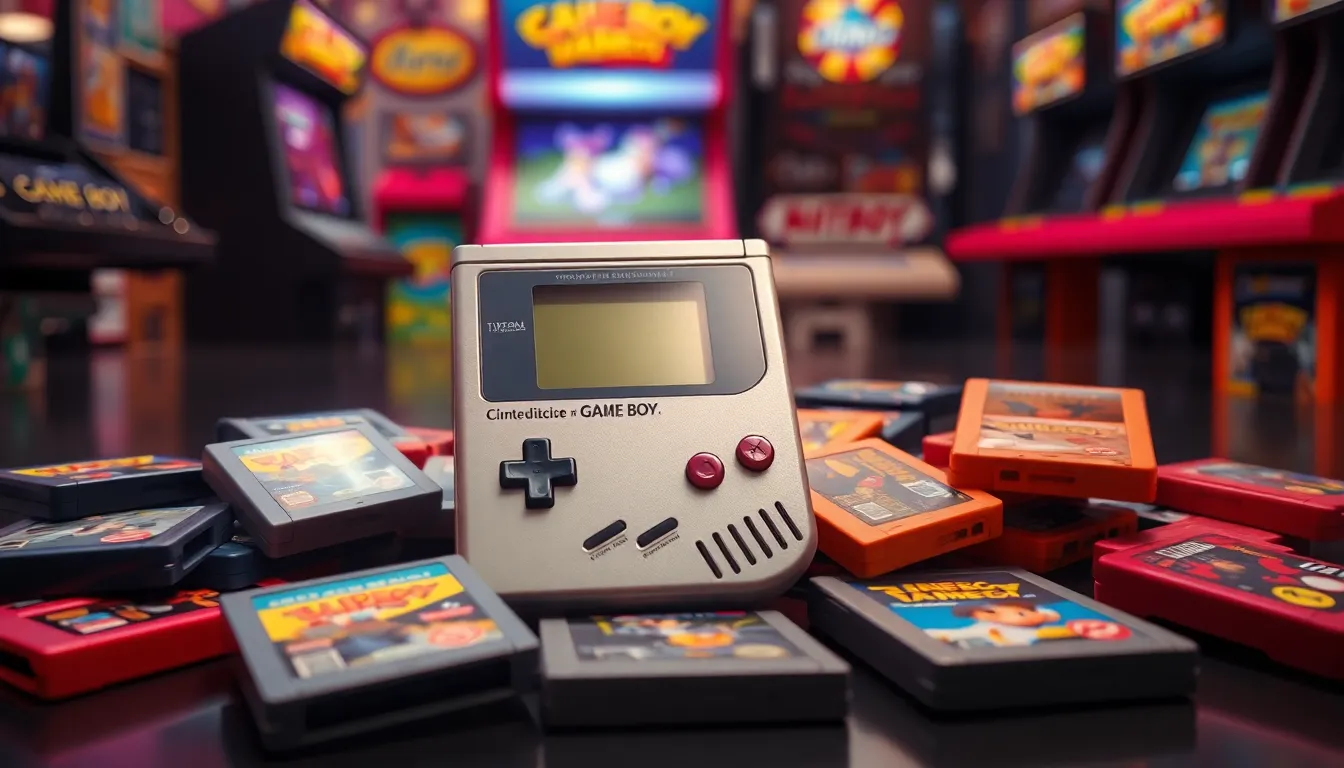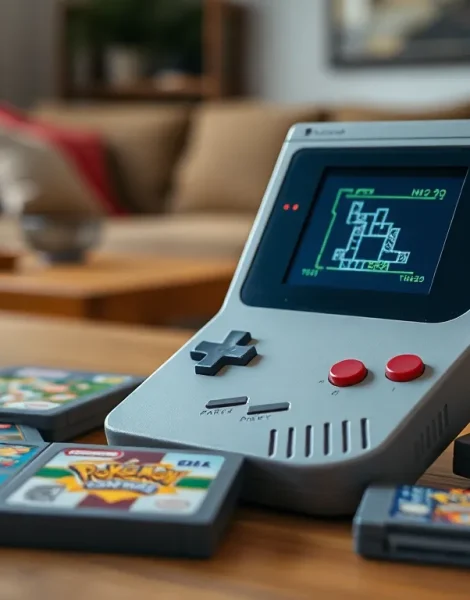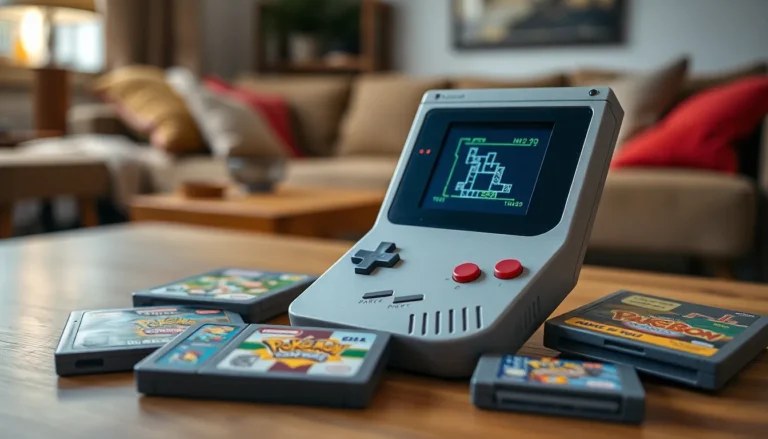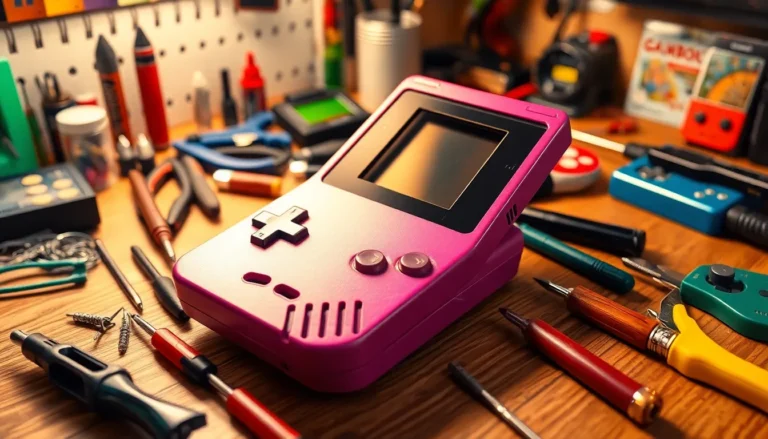The Game Boy revolutionized portable gaming when it launched in 1989, captivating millions with its innovative design and engaging gameplay. Inspired by a blend of cutting-edge technology and a desire for on-the-go entertainment, Nintendo’s iconic handheld console sparked a gaming phenomenon that continues to influence the industry today.
Its simple yet effective interface and a library of memorable titles laid the groundwork for future devices, making it a cornerstone of gaming history. As technology evolves, the Game Boy’s legacy remains a source of inspiration for developers and designers, reminding them of the power of creativity and nostalgia in shaping the gaming landscape.
Table of Contents
ToggleThe Legacy of Game Boy
The Game Boy’s legacy reflects its profound impact on portable gaming and game design. Launched in 1989, it set new standards for portable consoles, making gaming accessible beyond traditional settings.
Key Contributions to Gaming
- Innovative Design: The Game Boy featured a compact design that prioritized portability. Its lightweight, durable build allowed gamers to enjoy gameplay on the go.
- User-Friendly Interface: The interface simplified interactions, letting players engage with games easily. The button layout and controls contributed to an inviting gaming experience.
- Diverse Game Library: The console hosted iconic titles like Tetris and Pokémon, shaping the gaming landscape. These games’ success sparked interest in diverse genres and gameplay styles.
Influence on Future Consoles
- Portable Gaming Evolution: The Game Boy inspired subsequent devices such as the Nintendo DS and the PlayStation Portable. Innovations introduced in these systems often trace back to concepts established by the Game Boy.
- Game Development Practices: Developers learned the importance of creativity in gameplay, leading to unique titles that resonate with players. Its influence persists, as seen in modern indie games and mobile applications.
Cultural Significance
- Nostalgia Factor: The Game Boy evoked nostalgia among players who grew up with the system. This emotional connection drives continued interest in retro gaming and influences design choices in contemporary games.
- Community Building: The Game Boy fostered connections among gamers through shared experiences and memories. The rise of communities around retro gaming exemplifies its lasting influence on social engagement in gaming.
The Game Boy’s innovative features and cultural impact established it as a cornerstone of portable gaming. Its legacy continues to inspire and shape the gaming industry, making it a vital part of gaming history.
Influences on Game Design

The Game Boy significantly impacted game design, especially within the realm of portable gaming. Its innovative features and memorable titles laid the groundwork for future game development and device evolution.
Impact on Portable Gaming
The Game Boy established portable gaming as a viable market, prompting other companies to develop their handheld consoles. The introduction of high-quality graphics on a compact device influenced designs and specifications in competitors’ products. Examples include the Sony PlayStation Portable and the Nintendo DS, which adopted similar principles of accessibility and portability while enhancing graphics and gameplay experiences. The success of the Game Boy demonstrated the potential for engaging players outside traditional gaming settings, leading to a surge in handheld gaming popularity.
Shaping Game Mechanics
The Game Boy’s library of games emphasized simplicity and addictive gameplay mechanics. Titles like Tetris pioneered puzzle-based mechanics, promoting easy-to-understand yet challenging gaming experiences. Its turn-based RPGs, such as Pokémon, introduced strategic depth without overwhelming players. These game mechanics encouraged developers to prioritize engagement and accessibility, influencing the design of countless titles across platforms. The focus on multiplayer experiences also opened avenues for social interaction, creating connections among players and reshaping expectations surrounding multiplayer gaming.
Artistic Inspirations
The Game Boy’s influence extends into various artistic domains, particularly in visual aesthetics and sound design. These elements contribute significantly to the gaming experience.
Visual Aesthetics
The Game Boy’s visual aesthetics revolutionized portable gaming with its unique pixel art style. Developers utilized a limited color palette and resolution to create immersive environments and memorable characters. Iconic titles like “The Legend of Zelda: Link’s Awakening” and “Metroid II: Return of Samus” exemplified how constrained resources fostered creativity. Game designers often embraced minimalism, relying on strong silhouettes and imaginative designs to convey depth and emotion. The distinctive 8-bit graphics not only defined the era but also inspired modern indie developers seeking to capture the nostalgia of pixel art in their games.
Sound Design
The Game Boy’s sound design played a pivotal role in establishing its distinctive charm. Composers harnessed the console’s audio capabilities to create memorable soundtracks that resonated with players. Titles like “Tetris” and “Pokémon Red and Blue” showcased catchy chiptune melodies, using simple sound waves to evoke emotion and enhance gameplay. The incorporation of synthesized effects elevated player interaction, transforming basic actions into engaging experiences. Game audio composers became adept at maximizing limited audio channels, laying the groundwork for innovative sound design in future handheld devices.
Cultural Impact
The Game Boy’s cultural impact resonates profoundly within the gaming community and beyond. Its innovations sparked nostalgia and shaped modern gaming practices.
Nostalgia and Community
Nostalgia plays a vital role in the Game Boy’s cultural significance. Many adult gamers fondly remember their first gaming experiences, often shared with friends and family. Communities formed around iconic titles like Pokémon and Tetris, igniting a sense of connection among players. Events like Pokémon Go’s community days reflect this enduring bond, as former Game Boy users unite to celebrate shared memories. Fan art, online forums, and retro gaming conventions maintain the Game Boy’s legacy, reinforcing its place in gaming culture.
Influence on Modern Gaming
The Game Boy’s influence on modern gaming is undeniable. It established portable gaming as a legitimate market, leading to competitors like the PlayStation Portable and Nintendo Switch. The emphasis on user-friendly interfaces and engaging gameplay sets benchmarks for current developers. Mechanics introduced in Game Boy titles, such as simple controls and multiplayer options, remain prevalent in contemporary games. Additionally, the retro revival trend highlights how the Game Boy’s aesthetic and sound continue to inspire game design, demonstrating its lasting legacy in shaping the future of gaming.
The Game Boy’s remarkable journey through gaming history is a testament to its innovative spirit and cultural impact. Its ability to connect players and foster communities continues to resonate today. As new technologies emerge and gaming evolves, the Game Boy’s legacy serves as a guiding light for developers and designers alike.
Its influence on game design, aesthetics, and sound remains evident in modern titles, proving that simplicity and creativity can create unforgettable experiences. The nostalgia surrounding the Game Boy not only celebrates the past but also inspires future generations to explore the limitless possibilities of portable gaming.









